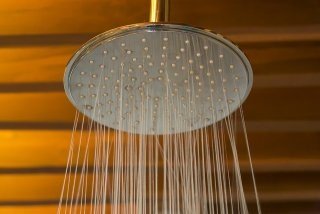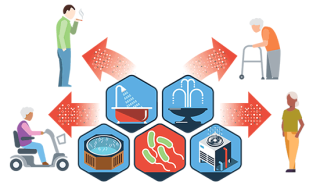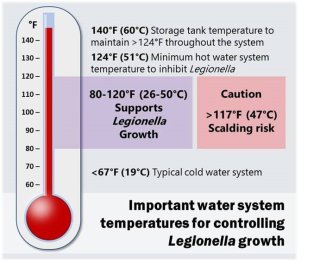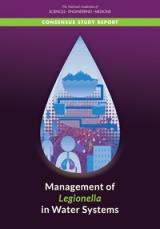Legionella in the Indoor Environment
Legionella is a type of bacteria that is found naturally in lakes, streams, ponds, other freshwater settings, and in some soils. Legionella can also be found in water distribution systems and plumbing in buildings.

Legionella can become a health concern when it grows and spreads in a building’s water system (i.e., water pipes and all devices that use water). Showerheads, sink faucets, and humidifiers can create spray, or small droplets, that can release bacteria into the air. People can become infected with Legionella when they breathe in spray or small droplets that contain the bacteria. Addressing Legionella in the indoor environment requires both water quality management and consideration of indoor air quality. This webpage offers practical strategies and resources to minimize the risk from Legionella in the indoor environment.
On This Page:
- How Can Legionella Affect My Health?
- Strategies to Prevent and Control Legionella Exposure
- EPA-Sponsored Research Activities on Legionella
- Building Standards and Additional Resources
Other EPA resources on Legionella:
- Ground Water and Drinking Water, Legionella
- Technologies for Legionella Control in Premise Plumbing Systems
How Can Legionella Affect My Health?
Legionella exposures primarily occur when a person breathes in spray or small droplets that contain the bacteria. A much less common route of exposure can occur when water droplets contaminated with Legionella get into the lungs accidentally when swallowing.
Legionella bacteria can cause Legionnaires’ disease, a serious type of pneumonia (lung infection), or a milder influenza-like illness known as Pontiac fever. Learn more about the signs and symptoms of Legionnaires’ disease and Pontiac fever.
Most healthy people exposed to Legionella do not get sick; however, some individuals may be more susceptible, including:
- People 50 years or older.
- Current or former smokers.
- People with weakened immune systems or who are immunocompromised.
- People with a chronic lung disease.
- People with cancer.
- People with underlying illnesses such as diabetes, kidney failure or liver failure.

If one does become ill with Legionnaire’s disease, it can be very harmful. About 1 in 10 people who get sick with Legionnaires’ disease die from the illness. The number of cases of Legionnaires’ disease has been on the rise since 2000. Health departments reported nearly 9,000 cases of Legionnaires’ disease in the United States in 2019, but the true number of cases is believed to be much higher. It is likely that Legionnaires’ disease is underdiagnosed because symptoms may resemble other lung infections. In 2021 Legionella was the cause of 50 % of waterborne disease outbreaks and 60% of deaths during those outbreaks.
Strategies to Prevent and Control Legionella Exposure
Legionella Prevention and Control in Your Home
Because Legionella bacteria occur naturally in water, it is important to maintain your home’s water system in a way that reduces the potential for bacterial growth and spread. There are several strategies that you can use in combination to prevent or reduce the growth of Legionella in your home’s water system. If you are unsure of whether to implement prevention strategies in your home, a healthcare provider or public health professional in your area can advise you.
Keep water fixtures clean
Keeping water fixtures clean will help to prevent or remove bacterial growth and reduce the amount of spray and small droplets that are easier to inhale. If you notice mineral build-up or slimy film on water fixtures, consider cleaning them more often. This might require you to remove the fixture, for example a showerhead and hose, and soak in a cleaning solution to remove buildup. Follow the manufacturer’s recommendations regarding the appropriate cleaning product and method.
When you use the shower, consider opening a window or using an exhaust fan to help remove the spray or small droplets from the room. Consider doing the same when using the sink for an extended period or if you are a high-risk individual. Selecting faucets and showers that have non-aerating fixtures and do not mix air and water may also reduce the amount of spray or small droplets released into the air. It is important to note that using non-aerating fixtures may result in increased water and energy use and associated costs. To minimize these costs, look for WaterSense labeled products.
High-risk individuals may also want to consider point-of-use (POU) filters for sinks and showerheads. Note, POU devices need to be maintained and must be replaced at regular intervals. Follow the manufacturer recommendations regarding frequency of replacement and appropriate operating conditions.
Other devices found in homes such as humidifiers, nebulizers and hot tubs that create spray or small droplets should be cleaned regularly. Follow the device manufacturer’s instructions on cleaning procedures/steps.
Learn more: CDC - Clean, disinfect, and maintain all devices that use water.

Temperature Control
Legionella grows best at temperatures between 80-120⁰F; keeping water in indoor plumbing either above (124⁰F) or below (80⁰F) can help control the bacteria.
Hot water in your home water system: Check your state or local building codes to see if there are any restrictions on increasing water heater temperatures. Setting the thermostat at or above 140⁰F can often keep temperatures high enough (above 124⁰F) throughout the plumbing system to prevent Legionella growth.
Caution: Hot water at the faucet or shower may present a scalding risk at temperatures above 117⁰F. Before increasing the temperature of the hot water in your home, consider who may be at risk. Those who are unaware of the high hot water temperatures, have delicate skin or are unable to respond quickly are at increased risk of scalding, especially young children, and older adults. The risk of scalding can be managed with thermostatic mixing valves placed as close as possible to water outlets. Thermostatic mixing valves are devices that mix cold and hot water to consistent, safe temperatures to prevent scalding. If you decide to install thermostatic mixing valves, make sure to follow the manufacturer’s instructions or have a professional do the work.
Setting your water heater thermostat at or above 140⁰F may increase the energy cost/usage for your home. One way to moderate this increase is to insulate the pipes to minimize heat loss and conserve energy.
Cold water in your home water system: Typical cold-water systems are unlikely to support Legionella growth, except in warm climates where the water temperature is approximately 80⁰F for extended periods of time. If this is the case, consider insulating the pipes to help minimize the cold-water piping from becoming warm enough to support growth.
Flushing the Water in Your Home
Flushing the water in your home after periods of disuse (for example, while you are away or during remodeling) will remove stagnant water. Stagnant water can lead to changes in water temperatures, lower levels of disinfectants and other conditions that provide opportunities for Legionella to grow. Other factors that contribute to stagnant water include piping that is subject to low or no flow, or decreased water use such as capped pipes or unused faucets (e.g., in a guest bathroom).
For water outlets that are not used frequently or have not been used for an extended period of time, consider running them on a weekly basis to flush them out.
- During this process, take care to minimize splashing and spray. If possible, turn on an exhaust fan or open the window and step away from the area to avoid breathing in spray or small droplets in the air that may contain the bacteria.
- Open taps and let the water run for approximately two minutes to remove water that has been standing in the pipes and/or water outlets.
- Flush the cold and hot water to replace the water that has been standing in the pipes. If you are flushing your whole house, start with the tap nearest to where water enters your home and move out from there.
- Cold water should be flushed before hot water. Run the cold water for two minutes. Run the hot water until it reaches its maximum temperature
Learn more: CDC - Flush your faucets and showerheads if they have not been used recently.
Regular flushing of sediments from your hot water tanks may also help control and prevent Legionella growth. If you decide to flush your water heater, make sure to follow the manufacturer’s instructions or have a professional do the work. Many manufacturers recommend flushing your water heater:
- Once a year
- Before you move into a home
- After plumbing work
- If the water is discolored
Caring for Private Drinking Water Wells
It is estimated that more than 13 million households rely on private wells for drinking water in the United States. EPA does not regulate private wells, nor does it provide recommended criteria or standards for individual wells. EPA offers information regarding the importance of testing private wells and guidance on technologies that may be used to treat or remove any contaminants, including biological contaminants like Legionella. Private well owners are responsible for the safety of their water.
Learn more: CDC – Private Ground Water Wells.
Legionella Prevention and Control in Multi-Family Buildings, Commercial Buildings and Schools
In situations where you do not have control over the operation of the water system, such as if you live in a multifamily building or at work and school, consider asking if your building operates a water management program. Water management programs describe preventive strategies that can be tailored and implemented for individual water systems, including identifying the person or team responsible for implementing the plan and monitoring compliance and effectiveness. Water management plans are widely recommended for Legionella control. For more details about managing building water systems, see:
- CDC - Overview of Water Management Programs.
- ASHRAE - Guideline 12-2020 - Managing the Risk of Legionellosis Associated with Building Water Systems.
- ASHRAE Standard 188-2021, Legionellosis: Risk Management for Building Water Systems
How to Protect Yourself and Your Family Away from Home
When outbreaks (or a group or cluster of cases) of Legionnaires’ disease occur, they are often associated with buildings or structures that have complex water systems, such as long-term care facilities, hospitals, cruise ships, hotels, and resorts. The most likely sources of infection include water used for showering, hot tubs, decorative fountains, and cooling towers. The Center for Disease Control and Prevention (CDC) analyzed reports from CDC-led investigations of Legionnaires’ disease outbreaks and found that nearly all were caused by problems preventable with more effective water management.
Hot tubs and spas have potential for Legionella growth if improperly maintained. CDC provides information about Legionella and Hot Tubs/Spas, including a list of questions to ask your hot tub or spa operator and steps you can take to test the water to determine if it is properly maintained.
Travelers at increased risk for infection may choose to avoid activities such as going into a hot tub or spa. Travelers should seek medical attention promptly if they develop symptoms of Legionnaires’ disease or Pontiac fever.
Reopening Buildings After No or Low Use
Buildings that have been vacant or that are operating at reduced occupancy may have stagnant or standing water which can increase the potential for Legionella and other bacteria. Standing or stagnant water in premise plumbing (i.e., the portion of the water distribution system from the water meter to the tap in homes and other buildings) can lead to a change in water temperatures as well as lower levels of disinfectant residual. These are conditions that promote the growth of Legionella and other bacteria. Care must be taken when reopening buildings after no or low use.
For more details, see:
- Information on Maintaining or Restoring Water Quality in Buildings with Low or No Use.
- CDC - Guidance for Reopening Buildings After Prolonged Shutdown or Reduced Operation.
EPA-Sponsored Research Activities on Legionella

Management of Legionella in Water Systems
The National Academies of Science, Engineering, and Medicine (NASEM) released a report in 2020, Management of Legionella in Water Systems, that reviews the state of science on Legionella contamination of water systems. The report outlines the diagnosis, ecology, and exposure pathway of Legionella, quantification of Legionnaires’ disease and Legionella, and strategies for Legionella control as well as regulations and guidelines on Legionella control in water systems.
- Full Report (Download free PDF or read online)
- Download PDF of the report release briefing presentation (PDF) (August 14, 2019)
For more information, see:
- Consensus Study Report Highlights (PDF)
- Report Highlights for Healthcare Professionals (PDF)
- Conclusion and Recommendations for Building and Facilities Management (PDF)
- Interactive Overview of Legionella in Water Systems: Science-Based Guidance for Facilities Managers
Building Standards and Additional Resources
- ANSI/ASHRAE - Standard 188-2021 Legionellosis: Risk Management for Building Water Systems
- NSF P453-2017 Cooling Towers - treatment, operation and maintenance to prevent Legionnaires' disease (Standard that addresses cooling towers)
- CDC - Legionella (Legionnaires' Disease and Pontiac Fever)
- OSHA - Legionella (Legionnaires' Disease and Pontiac Fever)
- Water management programs for building water systems and devices at risk for Legionella growth and transmission can lower the potential for illnesses and outbreaks. The problems that lead to Legionnaires’ disease are preventable through water management programs and CDC provides considerations for:
